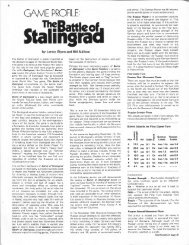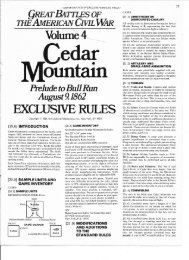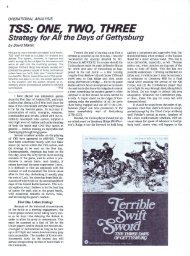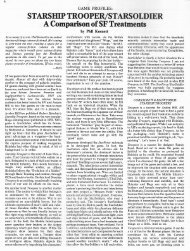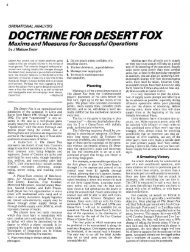Battlefleet Mars - RussGifford.net
Battlefleet Mars - RussGifford.net
Battlefleet Mars - RussGifford.net
You also want an ePaper? Increase the reach of your titles
YUMPU automatically turns print PDFs into web optimized ePapers that Google loves.
18<br />
GAME PROFILE<br />
BArrLEFLEET MARS<br />
A Believable Science-Fiction Game<br />
by Thomas G. Pratuch<br />
Designing the tactical movement system and<br />
wrlting much of the background for BFM were<br />
tasks that I found very satisfying. I'm of the<br />
opinion thai the game is more space-operatic than<br />
Mr. Pratuch seems to feel it is - but then I'm<br />
pretty austere when it comes to sf. Something I do<br />
wish to carryon from BFM is the tactical movement<br />
system which I believe can be developed into<br />
a standard movemen t system for many future<br />
space combat games. I'd app recia te hearing sug·<br />
gestions on this from those of you that care abou 1<br />
such things.<br />
-RAS<br />
Designing a conflict simulation in the<br />
area of science fiction immediately brings ou t<br />
strong opinions for or against the game. The<br />
opinions are divided between the one group<br />
who wants to see a game that is a logical forecast<br />
of human development and those who<br />
want to see voluptuous women being carried<br />
off by the (pick one) Bug-Eyed-Monsterl<br />
Evil Space Pirate Dirk Donogood/the Marauding<br />
Space Race. BattieFleet <strong>Mars</strong> does<br />
not have voluptuous women and totally lacks<br />
BEMs/space pirates/alien races. Instead it is<br />
a logical prediction of one possible path man<br />
could follow to exploit space. I am not going<br />
to say that all players will agree with the<br />
game's premise, but it is a believable one and<br />
the situation is developed logically from it.<br />
BattleFleet <strong>Mars</strong> (hereafter BFM) is a<br />
true conflict simUlation. Reading the player's<br />
notes will tell the gamer that the conclusion<br />
of the game is resolved more often by the<br />
political/morale points than because of military<br />
actions. This is not to say that battles do<br />
not occur. They do occur and quite often<br />
leave both sides with a morale loss because of<br />
the heavy destruction. This will be discussed<br />
in detail later .<br />
The game points up a very important<br />
fact about initial exploration/ development<br />
of new territory that is hard to reach. There<br />
has to be a strong economic basis behind the<br />
operation and when you start playing with<br />
economics there is a political tie-in of the<br />
operation with the government. If the operation<br />
doesn't pay for itself or otherwise becomes<br />
a burden to the stayed-at-home group,<br />
the political problems force the government<br />
to intervene. This is the rationale of the game<br />
in a very brief form. The game starts with a<br />
corporation having developed space for profit.<br />
The worker colonies that were started by<br />
the company decide that they should be independent<br />
to get a better deal. In the course of<br />
the colonies' fight for independence they try<br />
to exert an economic stranglehold on the<br />
Ares Corpoation (the founding company)<br />
and the world govemmenl.<br />
The existence of the world government<br />
is important because it acts as a third player<br />
in the game, so the two opposing players<br />
cannot just wage war without paying attention<br />
to the effect on the populace of Earth.<br />
The existence of the world government also<br />
explains why there are no vast armadas,<br />
formed by nations, floating around in space.<br />
All weaponry and ships are corporationdeveloped<br />
technology for mining, converted<br />
to war materials. The world government has<br />
no space fleet because such a force would not<br />
be necessary to enforce policy on Earth and<br />
the only people in space are the Ares colonists<br />
and spacemen.<br />
The colonies exert their economic power<br />
by withholding the raw material they mine<br />
and ship to Earth. Ares exerts its logistical<br />
control by controlling the technology necessary<br />
to repair and replace parts needed for<br />
the space units. These controls are in the<br />
game as limits ·on the production and repair<br />
points accrued by the colonists and the corporation.<br />
As an old sci-fi reader I would say<br />
that the game is faintly reminiscent of Heinlein's<br />
The Moon isa Harsh Mistress.<br />
Physical Layout<br />
There are two game maps that may be<br />
used separately or together (for the campaign<br />
..,,.<br />
it 41 /<br />
123 :!f 215 "!f 3D9':t1<br />
•<br />
Sha,z8m C
System Effectiveness<br />
Despite the potential for an incredibly<br />
complex game, SPI has produced an easily<br />
understandable one. Movement, combat and<br />
political operations are performed sequentially<br />
by the players. A good deal of the<br />
operations require some mental calculations<br />
which are aided greatly by the easily read<br />
charts in the game. As player experience with<br />
the game increases there will be less and less<br />
use of the charts because the presentation of<br />
data on the charts facilitates memorization.<br />
The problem of orbital mathematics is<br />
kept out of the game by handling combat as<br />
if it were away from a close orbit of the pla<strong>net</strong>.<br />
Therefore the ship fligh t paths are straight<br />
lines in the game. This in turn simplifies the<br />
calculations for maneuvering burns (Burning<br />
is acceleration via the expenditure of chemical<br />
fuel) to a small chart that gives the required<br />
fuel expenditure for a velocity change<br />
in all three dimensions.<br />
Players very quickly see the problems<br />
associated with two or more bodies maneuvering<br />
in space. It takes times and fuel to<br />
change direction. A scenario played by<br />
garners not familiar with BFM will find the<br />
opposing forces quickly running out of fuel<br />
as both groups fly helplessly off opposite<br />
ends of the tactical display. This ability of the<br />
game to show real problems encountered in<br />
space maneuvers rapidly turns the person<br />
who sees himself jetting around with unlimited<br />
power and fuel into a dissatisfied player.<br />
Those that can understand the physical laws<br />
represented in the maneuver rules will enjoy<br />
the game and win.<br />
It is the fuel/maneuver rules that inspire<br />
my Erst criticism of the game. When a ship<br />
(on the tactical display) runs out of fuel it is<br />
considered to be drifting helplessly. Recovery<br />
of the unit is determined by die roll and<br />
whether the unit is drifting around a friendly<br />
or enemy-held base. This is perfectly logical.<br />
But - a ship can be traveling at maximum<br />
possible speed by burning all fuel points except<br />
one point. This ship is not considered to<br />
be helpless despite the fact that the one remaining<br />
fuel point cannot seriously affect the<br />
flight of the ship. I suggest that ships must retain<br />
sufficient fuel at the end of a scenario to<br />
bring themselves to a halt on the tactical display.<br />
Then the ship could logically switch<br />
from the chemical fue l maneuvering rockets,<br />
used in local pla<strong>net</strong>ary space, to the fusion<br />
power generators for deep space flight between<br />
pla<strong>net</strong>ary bodies. Otherwise there is no<br />
logical way for the ship to correct its trajectory<br />
to bring the ship to a friendly base within<br />
the time limits of the game.<br />
As mentioned earlier in this article,<br />
combat is with equipment that was modified<br />
from its original purpose. The bulk of the<br />
combat is with lasers normally used to mine<br />
the raw materials by cutting asteroids, small<br />
moons, and general space debris into small<br />
enough sections for a ship (called a "catapult")<br />
to launch on a trajectory to Earth for<br />
processing. These lasers are capable of inflicting<br />
severe damage on an enemy ship<br />
caught in the beam of one laser. When the<br />
lasers are used simultaneously in groups of<br />
three, called a Laser Firing Group, these<br />
weapons can annihilate any ship caught in<br />
the group's beam. This is the second weak<br />
point of the game as the rules (or the story)<br />
do not even hint as to why this capability<br />
should exist. There is no reasonable way to<br />
suggest how three separate ships can so accurately<br />
coordinate their fires.<br />
On the strategic side of the game there is<br />
an effective demonstration of how space<br />
flight requires long-range planning. If a player<br />
plans to launch a fleet towards Jupiter<br />
from Earth (on the fourth game-turn for example)<br />
he will not be able to use that fleet at<br />
Jupiter until three turns later. If an opposing<br />
fleet decides to move away from Jupiter, or<br />
another opposing fleet causes a problem at<br />
the home pla<strong>net</strong>, then that fleet in transit to<br />
Jupiter is worthless for several turns.<br />
Overall BFM succeeds in far more of the<br />
mechanics of possible space flight/combat<br />
than it fails. In the more abstract problem of<br />
political opinion and morale c·onflicts the<br />
player is simply going to have to accept the<br />
point scales and die-roll results tables. There<br />
are no readily apparent inaccuracies and who<br />
can say what the success rates would really be<br />
if a colony agent tries to assassinate a corporation<br />
official? Or exactly how many points of<br />
Earth morale correspond to a successful or<br />
bungled attempt? The results are reasonably<br />
balanced so no player should leave the game<br />
crying "foul" because he disagrees with the<br />
charts provided.<br />
Strategy<br />
In keeping with SPI's dejacto policy of<br />
including player's notes with their more elaborate<br />
games, a gamer will find several pages<br />
of discussion and suggestions at the end of<br />
the rules booklet on different strategies that<br />
players should use. These suggestions are the<br />
result of the pre-publication testing and are<br />
well worth the reading. This is especially true<br />
since BFM has many features not familiar to<br />
garners from playing other games .<br />
There are two major strategies that I<br />
have seen in playing the game that are worth<br />
following. The first is repair before building<br />
new units. It is far faster and cheaper to keep<br />
several damaged ships operable than it is to<br />
build a new ship from scratch. If you have to<br />
build ships the catapult ship is the deadliest<br />
force away from a base but it has a weak repair<br />
capability. If you aren't going to fight<br />
with anything but lasers (more on combat in<br />
the tactics section) then the transport is the<br />
best bet to build because it has excellent selfrepair<br />
capabili ty.<br />
The second strategy is how the player<br />
thinks of the morale index. Do not plan an<br />
operation strictly from the aspect of how<br />
much your morale should go up. This logic<br />
quickly finds the player on the losing side.<br />
All too often a planned operation backfires<br />
and the player trying the operation finds his<br />
morale index heading for the center of his<br />
pla<strong>net</strong>. The best mental approach is to plan<br />
on how to drive the morale of the opponent<br />
down easiest. Then the friendly player will<br />
find his side coniing out ahead even though<br />
he may not necessarily gain many points.<br />
This is not to say that gambles should<br />
not be taken. After all the gamble that fails<br />
was a stupid idea, but the gamble that succeeds<br />
was brilliant strategy.<br />
Tactics<br />
As in strategy, the player definitely has<br />
to read the player's noteli. Repeated playing<br />
showed up several more tricks. The first was<br />
in using a laser firing group. Always make a<br />
laser group out of three ships with identical<br />
maneuvering capabilities. This not only<br />
makes it easier to keep planning to a minimum<br />
but prevents one ship from running low<br />
on fuel and forcing the group to break up.<br />
The second trick deals with combating<br />
laser groups. The group can easily eliminate a<br />
single ship/missile/fighter that tries to attack<br />
the group. If the player opposing the laser<br />
group does not have a group of his own, then<br />
his best bet is twin ships to attack. Each of<br />
these ships should launch either a missile, or<br />
fighter if so equipped, simultaneously. This<br />
way the group is at a disadvantage for one or<br />
more of the following reasons:<br />
(I) The two missiles form a salvo and,<br />
like the old submarine tactic, prevent the<br />
group from out-maneuvering the missiles!<br />
fighters.<br />
(2) If the missiles are launched closely<br />
enough to the group, there will not be sufficient<br />
opportunity for the group to eliminate<br />
the missiles before detonation. If the group<br />
tries to engage one missile with one ship (for<br />
each) the group will not be operating effectively.<br />
Also one ship beam does not have a<br />
great damage capability compared to a group<br />
beam.<br />
(3) The odds that one or more ships will<br />
be seriously damaged increases to a near<br />
certainty.<br />
General Comments<br />
The tactical scenarios ,"viii provide short<br />
games for garners with only a couple of hours<br />
free for play. The strategic game, with tactical<br />
combat handled by the abstract method,<br />
is suitable for several hours to one day of<br />
play. The full game with tactical/strategic interface<br />
is best played on a weekend so players<br />
will not feel rushed.<br />
One easily done variant, for garners<br />
wanting several tactical battles other than the<br />
scenarios, is for the players to divide the<br />
asteroids and Jupiter between them. Ignore<br />
all pla<strong>net</strong>s from <strong>Mars</strong> to Mercury and the<br />
rules for the strategic game - except for<br />
transit movement. This can be considered to<br />
be a quarrel between colonies and will give<br />
sufficient ships for several extensive battles<br />
without drawing the game out for many<br />
hours.<br />
19



